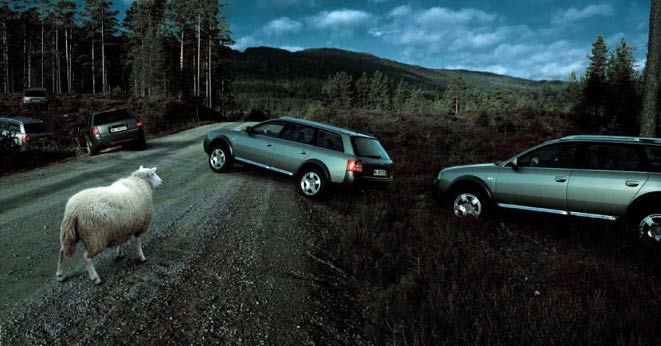A US federal court has ruled that Exxon need not pay the penalty for spilling over 11 million gallons of oil along more than 1,200 miles of Alaskan coastline in 1989. The BBC reports:
In the original court ruling, Exxon was ordered to pay out $5bn.
Later decisions ordered the lower Alaskan court to set a lower limit for the penalty, but refused to say how much the penalty should be cut by.
However, in the latest 2-1 judgement, Chief Judge Mary Schroeder and Judge Andrew Kleinfeld declared it was “time for this protracted litigation to end.”
I guess Exxon lawyers ground down the plaintiffs. Or maybe there is some political maneuvering underfoot? Seems incredible that the fee dropped a whopping 50%.
I mean after the first ruling way back in the 1990s it sounded like the oil giant was going to have to pay a lot, but a number like $5 billion has to be taken in perspective.
First of all, Exxon reported earning more than $10 billion in the fourth quarter of 2005, which was $2 billion more than the same quarter in 2004. Roughly speaking, that means a $5 billion penalty represents six months of profit for the company. That’s right, Exxon reported just under $40 billion in profits for 2005. This year has been a good one for them as well with their latest earnings call showing net income is still above $10 billion per quarter.
Second of all, if you put this in more down-to-earth terms it still does not seem like a lot for Exxon to pay relative to the damage/harm. Let’s say, for example, that instead of $40 billion in profit a year we talk about an average wage earner who brings home $40 thousand per year. What would the penalty be for that person if they were operating machinery while intoxicated and accidentally exterminated vast amounts of wildlife? I’m not sure how to deflate these numbers relative to the earnings, so here are the actual estimated dead from the Valdez spill:
250,000 seabirds, 2,800 sea otters, 300 harbour seals, 250 bald eagles, up to 22 killer whales, and an unknown number of salmon and herring.
Is a one-time $5 thousand dollar penalty excessive for a person who nets $40 thousand a year? What did it really cost in the short and long term to clean and repair the damage, as well as compensate those impacted by the accident? Like most externalities (things done by Exxon that hurts someone else), it’s hard to get exact numbers. The original ruling was $287 million in actual damages (that would be the equivalent of a $287 fine for the $40 thousand/yr wage-earner), but this did not account for long-term consequences such as those discussed in the news:
“I would just love to collect the Exxon oil that is on our beaches,” [Cordova, Alaska fisherman] Mike says, “and dump those gallons of oil on the front yard of its corporate headquarters. It’s been in my front yard for fourteen years.”
One of the grimmest aspects of the spill’s effect on Cordova has been the state of commercial fishing permits, once highly coveted. On the Sound, a permit is like a home — it is fisher’s greatest investment, something that stays in the family, an asset that accrues value. In 1988, there were fishers in Cordova whose permits were worth nearly a million dollars. Today, their permits — fishers often call them their “nest eggs” — have depreciated in value by a staggering 90%.
Three years after the spill the local marine population was so devastated (e.g. clams, herring, and seals) that it wiped out 85% of profits for the Native Regional Chugach Alaska Corporation and forced them into bankruptcy.
Third of all, maybe I’m looking at this from the wrong perspective. Perhaps we should not try to figure out whether the penalty is excessive relative to the profit or financial power of Exxon. Nevermind that $5 billion represented the annual profit of Exxon in 1994, the year punitive damages were originally set by an Anchorage jury. That makes perfect sense, but just for a moment let’s assume we just want to look at precedent relative to other rulings that deal with externalities and public harm. The tobacco industry, for example, settled for up to $360 billion. Wow. $5 billion now seems even smaller. There’s just one little problem with this line of argument — the federal government recently also unexpectedly significantly reduced its charges against the tobacco companies.
“We were very surprised,” said Dan Webb, lawyer for Altria Group’s Philip Morris USA and the coordinating attorney in the case. “They’ve gone down from $130 billion to $10 billion with absolutely no explanation. It’s clear the government hasn’t thought through what it’s doing.”
The Justice Department offered little explanation for the figure. Associate Attorney General Robert D. McCallum Jr. and members of the trial team declined to answer questions as the court session ended. In 2001, then-Attorney General John D. Ashcroft tried to settle or shelve the government’s racketeering case against the industry before a public outcry forced its revival.
“It feels like a political decision to take into consideration the tobacco companies’ financial interest rather than health interests of 45 million addicted smokers,” said William V. Corr, director of the Campaign for Tobacco-Free Kids. “The government proved its case, but the levels of funding are a shadow of the cessation treatment program that the government’s own expert witness recommended.”
Sources and government officials close to the case said the trial lawyers wanted to request $130 billion for smoking-cessation programs but were pressured by leaders in the attorney general’s office, particularly McCallum, to make the cut. Arguments within the Justice Department continued behind the scenes through yesterday morning, according to the sources, who spoke on the condition of anonymity because of the controversy over the matter.
Is there a connection? What was Robert McCallum’s position on Exxon? Wonder if he’s related to Exxon Valdez spill profiteer Eric McCallum who has “declined to identify” his business partner. Probably not, but given Robert’s reputation for conflict of interest you never know.
Well, aside from the Bush administration habit of placing the profits of their friends above the health and welfare of Americans, the states did manage to work out a $280 billion settlement with tobacco companies in 1998 (pre-Bush) that apparently led directly to successful health education programs. That again puts the Valdez $5 billion penalty in perspective.
Oh, and fourthly here’s another point that might be worth factoring: apparently last year the CEO of Exxon was given a $400 million retirement award, angering shareholders.
“Lee Raymond’s retirement package is a rubber-stamp on excessive spending by our company,” Reuters quoted one shareholder as saying.
Mr Raymond’s pay-off includes a retirement bonus of $98.4m, on top of last year’s $49m salary and a number of perks including use of a company jet.
Wonder if shareholders would have been as angry if the settlement had been, well, settled with that money instead. Seems like $5 billion divided by 17 years (since 1989) would be roughly $300 million per year. If you really want to be cynical, I guess you could compare the “pay-off” for the CEO to the amount earned the company just by fighting the Valdez settlement:
“Each year Exxon delays payment of its obligation,” the National Association of Attorneys General wrote in a 1999 letter to Exxon CEO Lee Raymond, “it earns an estimated $400 million from the difference between the statutory interest rate on judgments of 6 percent and the company’s internal rate of return of about 14 percent.”
So the $400 million golden parachute is really just from one year of refusing to settle the case. Multiply that by 17 ($6.8 billion) and you again can see why $5 billion is a small number….
Incidentally, I found another comparison point with the tobacco industry:
During his tenure at Exxon, Mr Raymond proved an unpopular figure among environmentalists, because he dismissed climate change as bunkum and helped fund groups that questioned the validity of global warming research.
Many of the protesters were realistic in their demands, saying that they did not want Exxon “to transform themselves into Greenpeace” but did expect the company to spend more on finding alternatives to fossil fuels.
The settlement with the tobacco industry has centered around educating people about the harms of smoking. Will Exxon ever be forced to teach people about the externalities of oil exploration, transportation and consumption? Ha! If they can keep reducing the fine for the direct result of an environmental catastrophe, then what are the chances they will be accountable for anything more complicated and subtle? Between their strong ties to the current President and Vice President, and their success from outspending their critics, something tells me that they will be quite content to continue ignoring risks to human health, dismiss any practical alternative energy, and continue exploiting natural resources without fear of accountability.

Perhaps the most memorable brief from this first round was the one in which Exxon claimed that crude oil was not a pollutant under the federal Clean Water Act, which it had violated.
“The crude oil on board the Exxon Valdez was not a waste,” Exxon Shipping attorney Edward Bruce said. “It was a commodity.”
Clever. No need to regulate something if you just change the word you call it? Bullets and guns become commodities? “Those things can’t hurt me, they’re commodities!” Drugs are commodities? What about the ingredients for methamphetamine? Commodities not regulated substances, right? Is there anything that Exxon would not classify as a commodity, once they admit that such a term includes anything that can be marketed relative to supply and demand?
Indeed, we should all realize it was just an opportunity washing up on shore, not toxic sludge. Too bad those dead animals and local industries did not know how to properly harness the commodity that destroyed their lives. I’m not kidding. Note this comment from actual case proceedings:
Judge Holland rejected all such arguments, concluding that “it is specious for Exxon to argue that it conferred a benefit on commercial fishermen by spilling oil.”
Someone should notify Wikipedia. Their description of the incident is far too pessimistic and doesn’t use the word commodity once:
The Exxon Valdez oil spill was one of the most devastating manmade environmental disasters ever to occur at sea, seriously affecting plants and wildlife. Its remote location (accessible only by helicopter and boat) made government and industry response efforts difficult, and severely taxed existing plans for response.
Finally, and fifth of all, some say this was a predictable disaster. Aside from the technicalities of the legal system and the murky waters of punitive damage theory, it is perhaps most interesting to note just how much sloppy work and risk Exxon and BP were willing (continue?) to allow in their Alaska operations.



